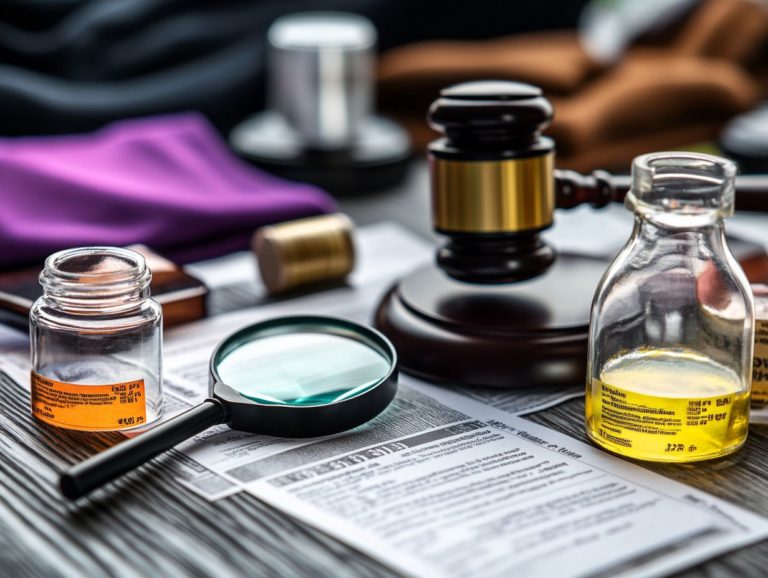How to Use Trademarks in Marketing
Trademarks are essential for defining your brand’s identity and success. They protect your brand and boost recognition, fostering loyalty among consumers.
Get ready to dive into the exciting world of trademarks! We ll cover what they are, their purpose, and the many benefits they offer in marketing strategies.
Learn how to distinguish your products and navigate the registration process effectively. Avoid common mistakes along the way!
Unlock the full potential of trademarks for your brand!
Contents
- Key Takeaways:
- Understanding Trademarks
- Benefits of Using Trademarks in Marketing
- Using Trademarks for Product Differentiation
- Incorporating Trademarks in Advertising
- Avoiding Trademark Infringement
- Trademark Registration Process
- Frequently Asked Questions
- What is a trademark and why is it important in marketing?
- How do I obtain a trademark for my business?
- Can I use someone else’s trademark in my marketing?
- What are the benefits of using trademarks in marketing?
- Can I use a trademark symbol without having a registered trademark?
- What should I do if I suspect someone is infringing on my trademark in their marketing?
Key Takeaways:

- Trademarks provide legal protection and enhance brand recognition.
- They help you create a unique brand identity.
- Effective use of trademarks in advertising is crucial to avoid infringement.
Understanding Trademarks
Understanding trademarks is crucial for business owners who want to create a distinct brand identity. In today s competitive marketplace, this knowledge is key.
Trademarks symbols, logos, or catchy phrases identify the source of your goods. They offer legal protection from others using your brand without permission.
Trademarks are more than just legal rights. They serve as vital marketing assets that enhance consumer recognition and build trust, contributing to your success across various industries.
Definition and Purpose
A trademark is a symbol, word, or phrase that distinguishes your goods or services. This creates a unique brand identity and ownership rights.
These identifiers make it easier for consumers to recognize products that meet their needs. For instance, the Nike swoosh represents not just shoes but a commitment to performance.
Canon’s trademark emphasizes quality in imaging technology, while Microsoft s logo signifies a range of software solutions.
Legally, trademarks protect you from confusion among consumers. This safeguard helps you maintain your unique identity in a competitive landscape.
Benefits of Using Trademarks in Marketing
Incorporating trademarks into your marketing strategies brings many advantages. You ll see increased brand recognition and strong legal protection against infringement.
These benefits significantly enhance your business s reputation and provide a competitive edge.
Legal Protection and Brand Recognition
Trademark registration offers essential legal protection against infringement. This keeps your brand secure and recognizable to consumers.
To register, submit an application to the United States Patent and Trademark Office (USPTO). Your trademark will be thoroughly examined for uniqueness and legal standards.
Common law protection exists but is limited without formal registration. Understanding these legal frameworks is crucial to avoid serious consequences in infringement cases.
Look to globally recognized brands like Coca-Cola and Nike for examples. Their trademark protection strengthens brand equity and builds consumer trust.
Using Trademarks for Product Differentiation

Using trademarks can greatly enhance your product differentiation. Unique trademarks help strengthen your brand identity and gain an edge in the market.
This strategic approach not only sets your offerings apart but also reinforces your brand’s value to consumers.
Creating Unique Brand Identity
A unique brand identity emerges from expertly crafted trademarks, including logos and symbols that stand out and leave a lasting impression on consumers. These elements do more than identify your brand; they convey your values and mission to your audience.
Logos serve as the visual cornerstone of your brand, while slogans provide memorable taglines that capture the essence of your message.
Take Ford, for example. Their iconic blue oval emblem and the slogan “Go Further” resonate with their commitment to innovation and reliability. Similarly, FlareTech has cleverly used its sleek design and the catchphrase “Ignite Your Potential” to solidify its standing in the tech industry.
Together, these components create a cohesive and recognizable brand that engages consumers on multiple levels.
Incorporating Trademarks in Advertising
Incorporating trademarks into your advertising campaigns is essential for elevating brand recognition and cultivating consumer awareness. However, it’s important to be aware of understanding trademark fair use to ensure that this strategic move transforms trademarks into a vital component of your marketing efforts, resonating effectively with your target audience.
Strategies for Effective Trademark Usage
Implementing strategies for effective trademark usage can significantly elevate your brand’s identity and enhance consumer engagement. Consistent branding across all platforms reinforces your identity and fosters consumer trust.
Using trademark symbols like TM, SM, and clarifies the status of your intellectual property, signaling to consumers the level of protection your trademarks enjoy. Protecting your trademark rights is crucial for your brand’s success! Neglect can dilute your reputation and weaken your market presence.
Adopting best practices around licensing can unlock new revenue streams and boost your brand’s visibility. Be aware that unregistered trademarks offer less protection in today s competitive landscape.
Avoiding Trademark Infringement
Avoiding trademark infringement is crucial for safeguarding your legal rights and upholding your reputation. This commitment to best practices in trademark usage protects your brand and reinforces your standing in a competitive landscape.
Best Practices for Using Trademarks

Adhering to best practices for trademark usage is essential for protecting your brand’s identity. To navigate trademark usage, you must understand the right contexts for displaying symbols like TM, SM, and . The TM symbol denotes a claim to a trademark, SM is reserved for service marks, and the symbol signifies a federally registered trademark, offering the highest level of protection available.
Prioritize maintaining your registrations by renewing them on time and remaining compliant with all legal requirements. Keeping an eye out for potential infringements is vital to safeguarding your brand s reputation; vigilant oversight can prevent unauthorized use and mitigate risks.
Fostering consumer awareness through strategic branding helps the public connect your products with your trademark. Seeking legal advice ensures that your brand’s interests are fiercely protected while navigating the nuances of trademark law.
Trademark Registration Process
The trademark registration process is essential for businesses that desire legal protection and exclusive rights over their trademarks. By securing your trademark, you ensure that your brand identity remains protected against potential infringements, allowing you to navigate the competitive landscape with confidence.
Start building your unique brand identity today!
Steps to Protect Your Brand
Taking the steps to protect your brand through trademark registration is essential. It ensures your legal rights are protected and keeps your brand identity unique.
Do a careful trademark search to spot potential conflicts before they become problems. This helps you avoid costly disputes later.
Filing your applications correctly and on time secures your important assets. This gives your brand the power to establish a stronger market presence.
Keep your registration up-to-date to ensure protection. Regular renewals are crucial.
These actions protect your brand and increase its recognition among consumers. As your brand becomes more identifiable and trustworthy, customers are more likely to engage.
Ultimately, this leads to increased loyalty and business growth!
Frequently Asked Questions
What is a trademark and why is it important in marketing?
A trademark is a unique symbol, word, or phrase that identifies and distinguishes a product or service. It helps consumers recognize a specific brand and its quality.
In marketing, trademarks are crucial for building brand recognition and loyalty.
How do I obtain a trademark for my business?

To obtain a trademark, start with a careful search to ensure it’s not already in use. If it s available, file an application with the USPTO.
The application process can be complex, so consider getting help from a trademark attorney.
Can I use someone else’s trademark in my marketing?
No, using someone else’s trademark without permission is trademark infringement. This can lead to legal action against your company.
Always conduct a trademark search to ensure your materials are conflict-free.
What are the benefits of using trademarks in marketing?
Trademarks are valuable assets that enhance brand recognition and protection. They help you create a unique identity and stand out from competitors.
Trademarks can also be licensed, providing additional revenue streams for your business.
Can I use a trademark symbol without having a registered trademark?
Yes, you can use the “TM” symbol to show that you are claiming ownership of a trademark, even if it’s not registered. This alerts others of your usage and can help protect it.
What should I do if I suspect someone is infringing on my trademark in their marketing?
If you suspect infringement, act quickly. Start by contacting the company and informing them of the issue.
If they don t stop, you may need legal assistance to protect your rights. Regular monitoring of your trademark is also important.






